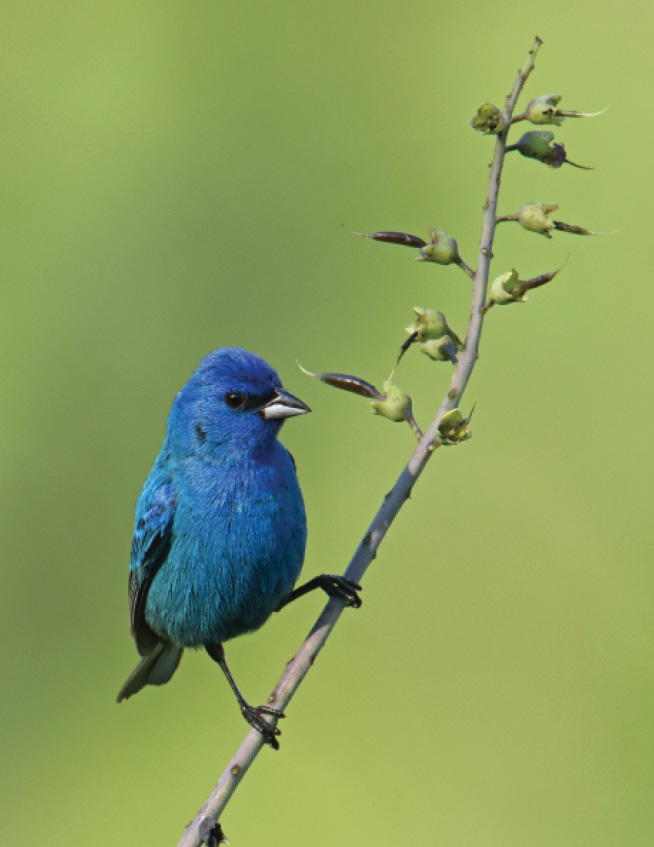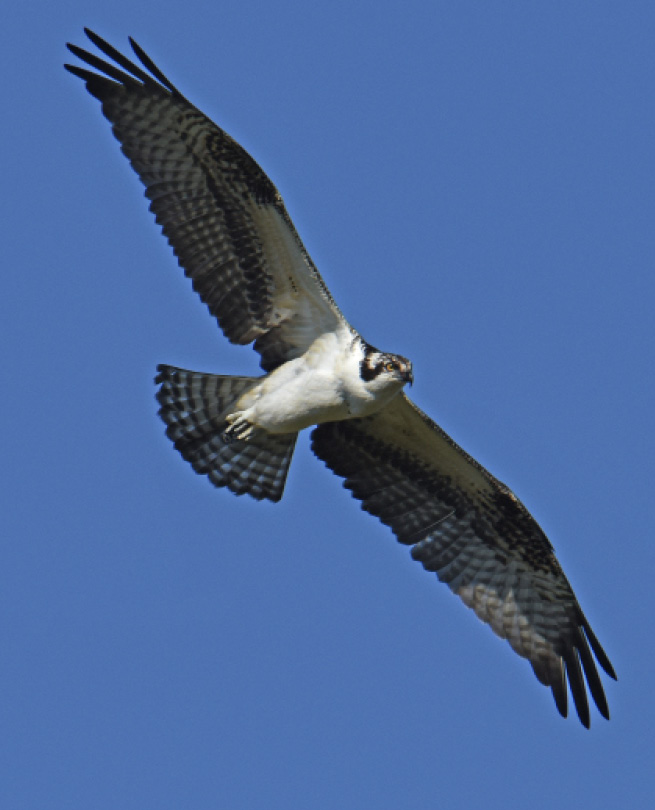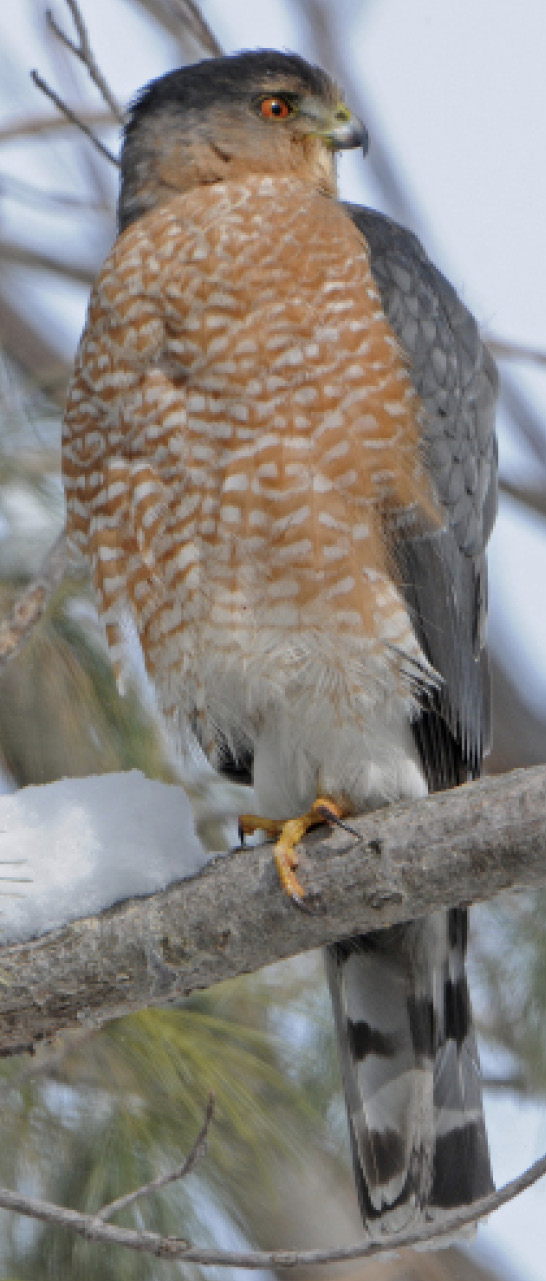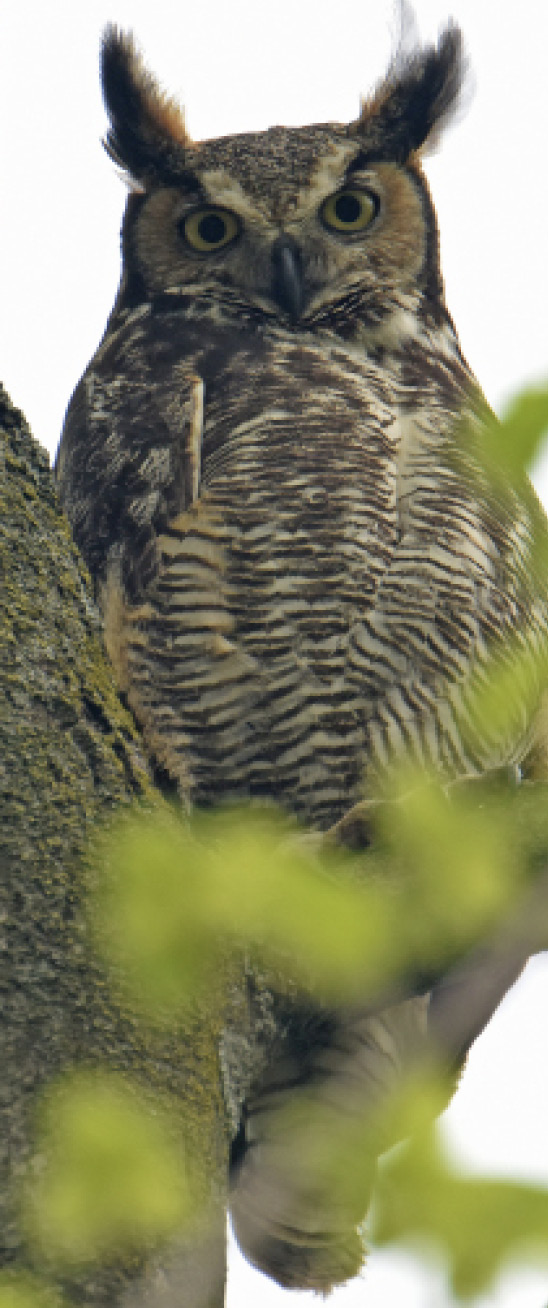Indigo Bunting
Passerina cyanea

Photo courtesy of Ken Saunders II, taken July 3, 2015, at the Sugar Creek Audubon Nature Sanctuary in rural Jasper County, Iowa
Song: Male indigo buntings whistle a bright, lively song of sharp, clear, high-pitched notes that lasts about two seconds. They are voluble, singing as many as 200 songs per hour at dawn and keeping up a pace of about one per minute for the rest of the day. Notes or phrases are often repeated in pairs: “what! what! where? where? see it! see it!” This pattern is recognizable, although the precise tune varies from place to place. Young indigo buntings learn their songs from males near where they settle to breed, and this leads to “song neighborhoods” in which all nearby males sing songs that are similar to each other, but that are different from those sung more than a few hundred yards away. (Description courtesy of the Cornell Lab of Ornithology.)
The all-blue male indigo bunting sings with cheerful gusto and looks like a scrap of sky with wings. Sometimes nicknamed “blue canaries,” these brilliantly colored yet common and widespread birds whistle their bouncy songs through the late spring and summer all over eastern North America. Look for indigo buntings in weedy fields and shrubby areas near trees, singing from dawn to dusk atop the tallest perch in sight or foraging for seeds and insects in low vegetation. (Description courtesy of the Cornell Lab of Ornithology.)
Click the player below to hear an audio recording of the indigo bunting, captured by Paul Marvin, courtesy of xeno-canto.
Western Osprey
Pandion haliaetus

Photo courtesy of Ken Saunders II, taken September 13, 2015, at Rock Creek Lake State Park, in Jasper County, Iowa
Song: Western ospreys have high-pitched, whistling voices. Their calls can be given as a slow succession of chirps during flight or as an alarm call—or strung together into a series that rises in intensity and then falls away, similar to the sound of a whistling kettle taken rapidly off a stove. This second type of call is most often given as an unfamiliar osprey approaches the nest. As the perceived threat increases, the call can build in intensity to a wavering squeal. (Description courtesy of the Cornell Lab of Ornithology.)
Unique among North American raptors for its diet of live fish and ability to dive into water to catch them, western ospreys are common sights soaring over shorelines, patrolling waterways, and standing on their huge stick nests, white heads gleaming. These large, rangy hawks do well around humans and have rebounded in numbers following the ban on the pesticide DDT. Hunting ospreys are a picture of concentration when they dive with feet outstretched and their yellow eyes sighting straight along their talons. (Description courtesy of the Cornell Lab of Ornithology.)
Click the player below to hear an audio recording of the western osprey, captured by Paul Marvin, courtesy of xeno-canto.
Cooper’s Hawk
Accipiter cooperii

Photo courtesy of Ken Saunders II, taken March 2, 2014, in Saunders’ back yard in northwest Grinnell, Iowa
Among the bird world’s most skillful fliers, Cooper’s hawks are common woodland hawks that tear through cluttered tree canopies in high speed pursuit of other birds. You’re most likely to see one prowling above a forest edge or field using just a few stiff wingbeats followed by a glide. With their smaller lookalike, the Sharp-shinned hawk, Cooper’s Hawks make for famously tricky identifications. Both species are sometimes unwanted guests at bird feeders, looking for an easy meal (but not one of sunflower seeds). (Description courtesy of the Cornell Lab of Ornithology.)
Song: Outside of the breeding season, Cooper’s hawks tend to be silent. The most common call is a loud, grating cak-cak-cak, 2-5 seconds long, given by both sexes in defense of the nest. This call is also given during courtship. Males frequently make a kik call to tell their mates where they are; females make this call too, but less often. Females make a whaa call when approaching or receiving food from males. (Description courtesy of the Cornell Lab of Ornithology.)
Click the player below to hear an audio recording of the Cooper’s hawk, captured by Richard E. Webster, courtesy of xeno-canto.
Great-Horned Owl
Bubo virginianus

Photo courtesy of Ken Saunders II, taken May 7, 2016, at Arbor Lake City Park in Grinnell, Iowa
With its long, earlike tufts, intimidating yellow-eyed stare, and deep hooting voice, the great- horned owl is the quintessential owl of storybooks. This powerful predator can take down birds and mammals even larger than itself, but it also dines on daintier fare such as tiny scorpions, mice, and frogs. It’s one of the most common owls in North America, equally at home in deserts, wetlands, forests, grasslands, backyards, cities, and almost any other semi-open habitat between the Arctic and the tropics. (Description courtesy of the Cornell Lab of Ornithology. )
Song: Great-horned owls advertise their territories with deep, soft hoots with a stuttering rhythm: hoo-h’HOO-hoo-hoo. The male and female of a breeding pair may perform a duet of alternating calls, with the female’s voice recognizably higher in pitch than the male’s. Young owls give piercing screams when begging for food, while adults may scream to defend the nest. Adults make an array of other sounds, including whistles, barks, shrieks, hisses, coos, and wavering cries. (Description courtesy of the Cornell Lab of Ornithology.)
Click the player below to hear an audio recording of the great-horned owl, captured by Lance A. M. Benner, courtesy of xeno-canto.

